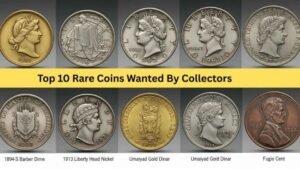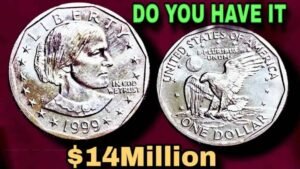Have you ever checked the cash in your wallet? That $5 bill might look ordinary, but some are worth much more than their face value. Rare $5 bills, especially those with a star symbol, can be worth up to $60,000 to collectors! These special bills, called star notes, are unique because they replace defective bills during printing. In this article, we’ll explain what star notes are, how to identify them, and why they can be so valuable. Let’s dive in!
What Are Star Notes?
Star notes are special U.S. dollar bills printed to replace ones that were damaged or misprinted during production. The U.S. Bureau of Engraving and Printing marks these replacement bills with a small star symbol (*) next to the serial number. This star shows that the bill is unique and not part of the regular print run.
Why Are Star Notes Valuable?
Star notes are rare because fewer of them are printed compared to regular bills. Their value depends on factors like:
- Rarity: Fewer star notes mean higher value.
- Condition: Bills in crisp, uncirculated condition are worth more.
- Serial Number: Unique or repeating numbers (like 00000001* or 12345678*) can increase value.
- Collector Demand: Some collectors pay top dollar for specific star notes.
A regular $5 bill might be worth $5, but a rare star note could fetch hundreds or even thousands at auctions!
How to Spot a Rare $5 Star Note
Identifying a star note is easy if you know what to look for. Here’s a step-by-step guide to check your $5 bill:
1. Look for the Star Symbol
Check the serial number on your $5 bill. If it ends with a star (*), you’ve got a star note! The star is usually at the end of the serial number, but it can also appear at the beginning on some older bills.
2. Check the Serial Number
The serial number is a mix of letters and numbers (e.g., MB12345678*). Rare serial numbers, like low numbers (00000001*) or repeating patterns (11111111*), make the bill more valuable.
3. Examine the Condition
Collectors prefer bills that are clean, crisp, and free of folds, tears, or stains. A star note in “uncirculated” condition (like it just came from the mint) is worth more.
4. Note the Series Year
The series year, printed on the bill, shows when it was designed. Older star notes, like those from the 1960s or earlier, are often rarer and more valuable.
5. Research the Print Run
Some star notes are part of small print runs, making them harder to find. You can check the bill’s series and serial number against online databases or collector guides to see how rare it is.
| Feature | What to Look For | Why It Matters |
|---|---|---|
| Star Symbol | A star (*) in the serial number | Marks it as a replacement note |
| Serial Number | Low, repeating, or unique numbers | Increases collectible value |
| Condition | Crisp, no folds or tears | Better condition = higher value |
| Series Year | Older years (e.g., 1960s or earlier) | Older notes are often rarer |
| Print Run | Small print runs | Fewer notes mean higher rarity |
How Much Is Your $5 Star Note Worth?
The value of a $5 star note depends on its rarity and condition. Here are some examples:
- Common Star Notes: Most $5 star notes are worth $10–$50 if in good condition.
- Rare Serial Numbers: A $5 star note with a low serial number (like 00000001*) could be worth $1,000 or more.
- Ultra-Rare Notes: Some star notes from specific series or with unique patterns have sold for $60,000 at auctions!
To find the exact value, check with a professional appraiser or look up recent sales on auction sites like eBay or Heritage Auctions.
Where to Sell Your Star Note
If you think you have a valuable star note, here’s where you can sell it:
- Online Marketplaces: Sites like eBay allow you to list your bill for collectors.
- Auction Houses: Professional auction houses like Heritage Auctions specialize in rare currency.
- Local Coin Shops: Visit a local dealer for an appraisal or quick sale.
- Currency Shows: Attend collector events to meet buyers directly.
Always get your bill appraised by a professional to ensure you get a fair price.
Tips to Avoid Scams
When selling your star note, be cautious:
- Verify Buyers: Only deal with reputable buyers or platforms.
- Get an Appraisal: Have your bill valued by a professional before selling.
- Avoid Overpaying for Grading: Grading services can be costly, so only use them for high-value notes.
Conclusion
Your $5 bill could be a hidden treasure if it’s a rare star note! By checking for the star symbol, examining the serial number, and assessing the bill’s condition, you can spot a valuable note. Whether you’re a collector or just curious, it’s worth taking a second look at the cash in your wallet. Who knows? You might find a $5 bill worth thousands!
FAQs
What is a star note?
A star note is a U.S. dollar bill printed to replace a defective one. It has a star (*) in the serial number.
How do I know if my $5 star note is valuable?
Check the serial number, condition, and series year. Low or unique serial numbers and crisp condition increase value.
Where can I sell my star note?
You can sell on eBay, at auction houses, local coin shops, or currency shows.
Are all star notes worth a lot?
Not all star notes are valuable. Common ones may only be worth $10–$50, but rare ones can fetch thousands.
How do I avoid scams when selling?
Work with reputable buyers, get an appraisal, and be cautious about costly grading services.




